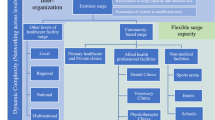Abstract
Hospitals have frequently been evacuated because of natural or man-made disasters. In this article, we identify elements to be considered when confronted with the possibility of hospital evacuation. Hospital evacuation may have a significant impact on the surrounding community and the overall population. When the patients in a hospital are placed at risk, hospital leadership often decides to evacuate the facility to safeguard the well-being of both patients and staff. Such a decision is not likely to be criticized. We present various considerations. The effect of evacuation on patients, hospital staff, family members, the community, and even the nation as a whole, as well as repercussions affecting potential patients should be integral to the decision-making process and parallel to the risk assessment.
Similar content being viewed by others
References
PAHO. Should a hospital be evacuated? Hospitals in Disasters: Handle with Care; 8–10 July 2003, San Salvador, http://www.paho.org/english/dd/ped/curso-hospitales.htm.
Schultz, C.H., Koenig, K.L., Auf der Heide, E. and Olson, R. (2005) Benchmarking for hospital evacuation: A critical data collection tool. Prehospital & Disaster Medicine 20 (5): 331–342.
Pape, J.W., Johnson, W.D. and Fitzgerald, D.W. (2010) The earthquake in Haiti – Dispatch from Port-au-Prince. New England Journal of Medicine 362 (7): 575–577.
Maybauer, D.M., Megna, M., Kafka, G. and Maybauer, M.O. (2009) Hurricane Ike and the University of Texas Medical Branch Hospital's evacuation. Anaesthesist 58 (12): 1244–1251.
Thomas, J. and Lackey, N. (2008) How to evacuate a psychiatric hospital: A Hurricane Katrina success story. Journal of Psychosocial Nursing and Mental Health Services 46 (1): 35–40.
Barnett, J., Dennis-Rouse, M. and Martinez, V. (2009) Wildfire disaster leads to facilities evacuation. Orthopaedic Nursing 28 (1): 17–20.
Augustin, J. and Schoettmer, J.T. (2005) Evacuation of a rural community hospital: Lessons learned from an unplanned event. Disaster Management & Response 3 (3): 68–72.
JCAHO. (2009) Are you on board with the Joint Commission's FPPE/OPPE requirements? Hospital Peer Review 34 (12): 137–141.
Getenkort, P., Harke, H., Blazejak, J., Pache, B. and Leledakis, G. (2002) Interface between hospital and fire authorities – A concept for management of incidents in hospitals. Prehospital & Disaster Medicine 17 (1): 42–47.
Manion, P. and Golden, I.J. (2004) Vertical evacuation drill of an intensive care unit: Design, implementation, and evaluation. Disaster Management & Response 2 (1): 14–19.
Schultz, C.H., Koenig, K.L. and Lewis, R.J. (2003) Implications of hospital evacuation after the Northridge, California, Earthquake. New England Journal of Medicine 348 (14): 1349–1355.
Taaffe, K.M., Kohl, R. and Kimbler, D.L. (2005) Hospital evacuation: Issues and complexities. In: M.E. Kuhl, F.B. Steiger, F.B. Armstrong and J.A. Joines (eds.) Proceedings of the 2005 Winter Simulation Conference, pp. 943–950, http://www.informs-sim.org/wsc05papers/111.pdf.
New York Centers for Terrorism Preparedness and Planning (NYCTP). Hospital evacuation protocol. DRAFT March 2006. HRSA; New York, http://www.nyc.gov/html/doh/downloads/pdf/bhpp/bhpp-hospital-nyctpevac-plan.pdf.
World Health Organization. Safe hospitals in emergencies and disasters. Western Pacific Region, http://www.wpro.who.int/NR/rdonlyres/390133EC-089F-4C77-902D-DFEE8532F558/0/SafeHospitalsinEmergenciesandDisasters160709.pdf.
Bagaria, J., Heggie, C., Abrahams, J. and Murray, V. (2009) Evacuation and sheltering of hospitals in emergencies: A review of international experience. Prehospital & Disaster Medicine 24 (5): 461–467.
Taffe, K., Johnson, M. and Steinmann, D. (2006) Improving hospital evacuation planning using simulation. In: L.F. Perrone, F.P. Wieland, J. Liu, B.G. Lawson, D.M. Nicol and R.M. Fujimoto (eds.) Proceedings of the 2006 Winter Simulation Conference, pp. 509–515, http://www.informs-sim.org/wsc06papers/062.pdf.
Schultz, C.H., Koenig, K.L. and Lewis, R.J. (2007) Decision-making in hospital earthquake evacuation: Does distance from the epicenter matter? Annals of Emergency Medicine 50 (3): 320–326.
Richardson, D.B. and Kumar, S. (2004) Emergency response to the Canberra bushfires. The Medical Journal of Australia 181 (1): 40–42.
Childers, A.K. and Taffe, K.M. (2010) Healthcare facility evacuations: Lessons learned, research activity, and the need for engineering contributions. Journal of Healthcare Engineering 1 (1): 125–140.
Krumholz, H.M. et al (1998) Prognostic importance of emotional support for elderly patients hospitalized with heart failure. Circulation 97 (10): 958–964.
AHRQ. (2008) Lessons learned from the field of emergency preparedness, http://www.ahrq.gov/prep/fieldemprep.
Einav, S. et al (2004) Evacuation priorities in mass casualty terror-related events: Implications for contingency planning. Annals of Surgery 239 (3): 304–310.
Wahlström, L., Michélsen, H., Schulman, A. and Backheden, M. (2009) Psychological distress and sick leave in Swedish survivors of the 2004 tsunami: A comparison with a population sample. The Journal of Nervous and Mental Disease 197 (12): 918–922.
Birkmann, J. and Fernando, N. (2008) Measuring revealed and emergent vulnerabilities of coastal communities to tsunami in Sri Lanka. Disasters 32 (1): 82–105.
Madhiwalla, N. and Roy, N. (2009) Bombing medical facilities: A violation of international humanitarian law. Indian Journal of Medical Ethics 6 (2): 64–65.
Reynolds, B.J. (2010) Principles to enable leaders to navigate the harsh realities of crisis and risk communication. Journal of Business Continuity & Emergency Planning 4 (3): 262–273.
Fischhoff, B. (2011) Communicating about the risks of terrorism (or anything else). American Psychologist 66 (6): 520–531.
Author information
Authors and Affiliations
Corresponding author
Additional information
Hospital evacuation affects patients, hospital staff, family members, the community, and even the nation; thus consideration of these effects should be integral to risk-assessments and decision-making processes.
Rights and permissions
About this article
Cite this article
Adini, B., Laor, D., Cohen, R. et al. Decision to evacuate a hospital during an emergency: The safe way or the leader's way?. J Public Health Pol 33, 257–268 (2012). https://doi.org/10.1057/jphp.2012.2
Published:
Issue Date:
DOI: https://doi.org/10.1057/jphp.2012.2




